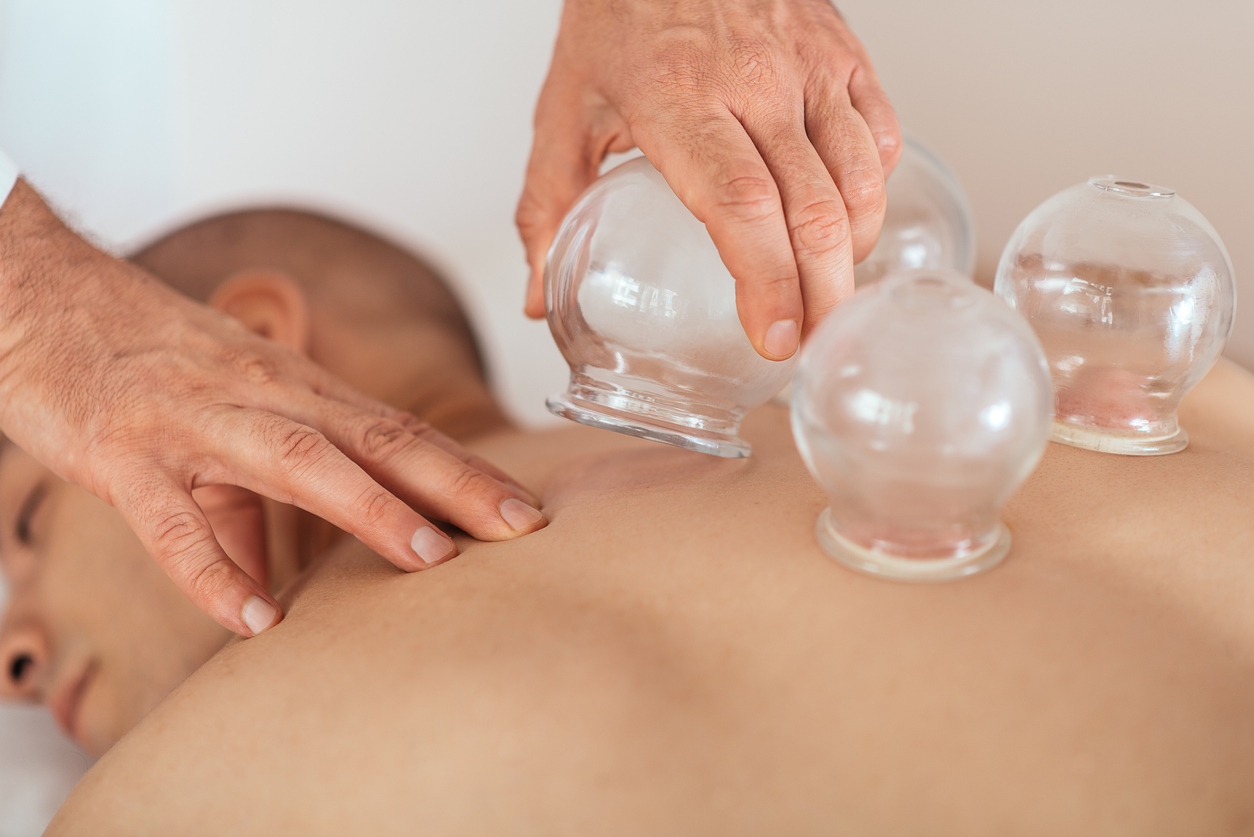Cupping therapy is an ancient technique that appears in numerous ancient medical systems, including Chinese, Unani, Korean, Tibetan, and Oriental medicine.1 The oldest medical text to mention cupping therapy is Eber’s papyrus (1550 BC) from Ancient Egypt. Hippocrates, the ancient Greek physician, mentioned cupping in a collection of medical notes describing the different types of cups and methods of application. Furthermore, cupping therapy was commonly used in Arabic and Islamic countries; physicians such as Ibn Sina (AD 980-1037), Al-Zahrawi (AD 936-1036), and Abu Bakr Al-Razi (AD 854-925) described cupping sites and created illustrations of cupping tools with accompanying diagrams. During the Renaissance, between the 14th and 17th centuries, cupping therapy spread to Italy and, subsequently, all of Europe.1 Although cupping is an ancient treatment used by various cultures and societies, its mechanism was not well understood until, recently, interest in cupping re-emerged and scientists began investigating in mechanistic underpinnings.2
There are many types of cupping therapy, but dry and wet cupping are the most common. In dry cupping, skin is pulled into the cup without scarification; in wet cupping, the skin is lacerated so that blood is drawn into the cup.2 Each cupping session lasts about 20 minutes. In the first step, the therapist disinfects specific skin points marked for cupping. Next, a suitably sized cup is placed on the selected area, heat or manual suction is applied to create a vacuum inside the cup, and the cup is left for a period of three to five minutes. For wet cupping, a sanitized surgical scalpel, needle, or auto-lancing device is used to create superficial incisions on the skin3; the cup is then reapplied to the skin for three to five minutes, and the area is disinfected with an FDA approved disinfectant and dressed.4
A converging amount of evidence supports the positive effects of cupping. To elaborate, cupping therapy leads to improved pain control by increasing endogenous opioid production in the brain, and promotes comfort and relaxation on a systemic level. Furthermore, researchers propose that cupping therapy improves blood circulation and enhances removal of toxins and waste from the body, which helps in normalizing the patient’s functional state and progressive muscle relaxation.5 Cupping also removes noxious materials from interstitial compartments and skin microcirculation. In men, cupping therapy is an effective method of reducing low density lipoprotein and, therefore, may help prevent atherosclerosis and cardiovascular diseases.6 Additionally, cupping is known to significantly decrease total cholesterol, and the ratio of low density lipoprotein to high density lipoprotein. According to Hao et al, cupping therapy can lower the number of lymphocytes in the local blood near the affected area and increase the number of neutrophils, which serves as an antiviral mechanism reducing pain sores. Overall, cupping leads to several positive effects with respect to the biochemical properties of the skin, pain modulation, and reduced inflammation.8
There are several proposed mechanisms of action for cupping. According to the immunomodulation theory, cupping therapy and acupuncture shared the same mechanism. The theory suggests that changes in the microenvironment of the skin, e.g. by stimulation, create biological signals that activate the neuroendocrine immune system.9 According to the genetic theory, mechanical stress on the skin – due to sub atmospheric pressure – and local anaerobic metabolism during cupping therapy produces physiological and mechanical signals that modulate gene expression. In wet cupping, for example, superficial scarifications may activate genetic programs for wound-healing.9 In summary, cupping therapy is an ancient technique that leads to numerous positive effects on pain modulation, blood circulation, waste removal, and the immune system. The immunomodulation and genetic theories provide possible mechanisms of action, though clinical researchers have not reached a consensus.
References
- N.A. Qureshi, G.I. Ali, T.S. Abushanab, A.T. El-Olemy, M.S. Alqaed, I.S. El-Subai, et al. History of cupping [Hijama]: a narrative review of literature. J Integr Med, 15 (3) (2017 May 31), pp. 172-181
- Rozenfeld Evgeni, Kalichman Leonid. New is the well-forgotten old: the use of dry cupping in musculoskeletal medicine. J Bodyw Mov Ther. 2016;20(1):173–178.
- Al-Rubaye K.Q.A. The clinical and Histological skin changes after the cupping therapy (Al-Hujamah)’ J. Turkish Acad. Dermatol. 2012;6:1.
- Shaban T. Professional Guide to Cupping Therapy. first ed. CreateSpace Independent Publishing Platform; 2009.
- Yoo Simon S., Tausk Francisco. Cupping: east meets west. Int J Dermatol. 2004;43:664–665. 9.
- Niasari Majid, Kosari Farid, Ahmadi Ali. The effect of wet cupping on serum lipid concentrations of clinically healthy young men: a randomized controlled trial. J Alternative Compl Med. 2007;13:79–82.
- Hao P., Yang Y., Guan L. Effects of bloodletting pricking, cupping and surrounding acupuncture on inflammation-related indices in peripheral and local blood in patients with acute herpes zoster. Zhongguo Zhen Jiu. 2016;36:37–40. 1.
- Lin M.L., Lin C.W., Hsieh Y.H. Bioelectronics and Bioinformatics (ISBB), IEEE International Symposium on. IEEE; 2014. Evaluating the effectiveness of low level laser and cupping on low back pain by checking the plasma cortisol level; pp. 1–4.
- Y. Guo, B. Chen, D.Q. Wang, M.Y. Li, C.H. Lim, Y. Guo, et al. Cupping regulates local immunomodulation to activate neural-endocrine-immune work net. Complement Ther Clin Pract, 28 (2017 Aug 31), pp. 1-3
